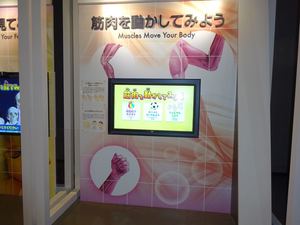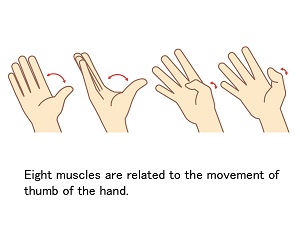Nagoya City Science Museum
TOP > Exhibition Guide > Floor Map> Muscles Move Your Body
Muscles Move Your Body



Purpose of Exhibition
This virtual game enables the player to learn how muscles move by touching the muscles of the arms and legs displayed on the screen and by bending and extending the joints displayed.
The player challenges three types of movements to achieve a higher score: keeping a paper balloon aloft (using an elbow joint), kicking a ball (using a knee joint and hip joint), and play rock, paper and scissors (using finger joints).
Through this game, the player learns that each joint has two types of muscles that move in opposite directions and that a complex movement requires the coordination of multiple muscles.
Additional Knowledge
[Elbow joint]
Bend your elbow and put muscle there, and you will feel your biceps contract, bunching up between your elbow and shoulder (on the front part of your arm). Then, straighten your elbow, and you will feel your outside muscle getting stiff. Like this, at least two different muscles are needed to move a joint in two opposite directions.
[Ankle joint, knee joint, and hip joint]
In a game of kicking a soccer ball, you need to move the knee joint and hip joint (the joint at the top end of the upper leg).
To bend and extend these joints on the screen, you need to perform four operations, though such motion involves the movements of more muscles. In reality, the action of kicking a ball requires the movements of ankles and other joints. Moreover, a large number of muscles, including those of the waist, back and arms, are used to stand on one foot while kicking a ball.
On this screen, a simplistic approach has been taken for the operation to use all of these muscles.
[Finger joints]
The third is a game of rock, paper and scissors. You start with the same hand gesture showing any of the three hand signs representing rock, paper and scissors as that of the other player, and move fingers to show any hand sign to win. The movements of finger joints are also simplified on the screen.
For example, the motion of the thumb involves eight muscles, which enable fingers to catch small things, use tools, and perform other complex movements.
[Why are hip muscles so large?]
Humans have bigger hip muscles than non-human primates. This is because humans have evolved to walk upright. The muscles of the hip function to support the body, allowing us to stand upright and move the thigh backwards or outwards.
In everyday life, we stand and walk without conscious effort, but such action requires a lot of power, which is represented by large hip muscles.
Article by Tomoko Horiuchi, curator
